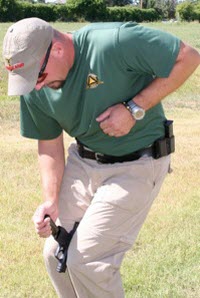 What is the real reason we should train to use only one hand to manipulate and shoot the firearm?
What is the real reason we should train to use only one hand to manipulate and shoot the firearm?
Lots of people might say, “Because it is common to get shot in one of your extremities and lose the use of one hand.” While I agree, and the statistics confirm this to an extent, over the years I have witnessed some other factors that force us to use one hand, and some of these factors might change the way we look at and select techniques for one-hand-only operation. Depending on the reason we are manipulating the handgun with one hand, we might also realize very quickly that some techniques are good for certain situations, and others are basically useless. One-handed survival training is a must have in your defensive handgun training program, and for you rifle operators, I suggest you entertain the idea of handling your rifle with one arm only too!
In the one-handed survival-shooting course I teach, I run through a variety of techniques that allow someone to accomplish all of the basic manipulations of the handgun: draw, reload, and malfunction clearances. My goals in this article are to inform you of the importance of this type of training and to give you some basics to consider in relation to training to shoot and manipulate your gun with one hand.
Going to One Hand
First, let’s look at the two common circumstances that force us to fight with only one hand. There are two general situations that force us to use one hand only, but many different scenarios in each arena.
Hand/Arm Wounded
This is the essential reason most people do one-handed manipulation training, because it is the one we have read about or seen and that causes the most fear. Imagine having to fight your way through a situation after receiving a wound that eliminates the use of one arm–not fun. The focus here needs to be on using one-handed manipulation techniques that allow us the most flexibility in terms of movement and use of potential cover. Obviously, we do not want to stand still if we are in the fight and have been wounded in some manner.
It is critical in your training process that you think about the order of events that would be most likely to guarantee your success and practice them relative to what you would want to do in the fight. For example, if your slide locks to the rear during the fight, forcing you to do an emergency reload, and sometime during that fight you are wounded, moving offline might be a better option than standing there and trying to facilitate a one-armed reload.
A second part of this is if you have trained with and can use a technique while you are on the move, you might embrace that technique rather than one that causes you to stand still in this particular situation. Regardless of what technique you use, I have found that the best option to avoid getting shot (tested extensively with NLTA and paintball) is to get offline (some call this “off the X”) as aggressively as possible and then do the reload once you are in some other spot, hopefully behind cover.
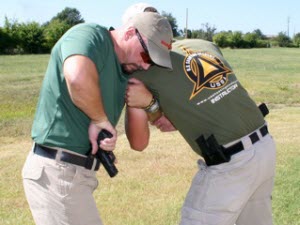
Your other hand may be occupied for some reason other than an injury.
www.personaldefensenetwork.comHand/Arm Occupied
This is the second reason that the arm might be unusable and is as common as or more so than losing the use of an arm after being wounded. Situations I have observed that will occupy the arm include holding an opponent (fighting, cuffing, etc.), carrying something important (e.g., a baby), and dragging or helping your partner or teammate in a combat situation. When having to access or manipulate the gun when one hand is otherwise engaged, you might find some techniques less effective than others.
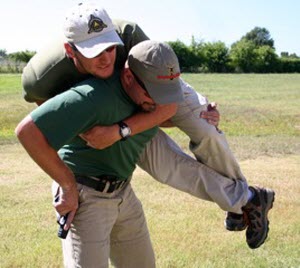
You may have to fix a malfunction and fight without dropping what you’re carrying.
www.personaldefensenetwork.comIf you have to manipulate the gun with one hand while the other hand is doing something that takes a good deal of strength, such as fighting another person, assisting a partner, or controlling a principal, you might find it very hard to use certain reloading and malfunction clearance techniques, which is why it is a good idea to know and train with several techniques that might each be used differently.
Other Considerations
Other things that need to be considered and discussed are gun/gear access, gun/gear set-up, and how to objectively select the right techniques that will give you the skills you need.
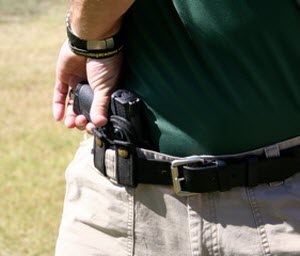
Do your holster and carry location make your gun easily accessible to both hands?
www.personaldefensenetwork.comGun Access
As far as gun access (draw process) with one hand occupied, your preference should be drawing with your strong hand, so get in the habit of having your strong (gun) hand available and occupying the other hand with non-pertinent tasks. If you do this, the strong draw process should really not change much from what you normally do, except the second hand will not be placed on the gun. If you violate this principle of keeping your strong hand free, you might find yourself set up for failure if you have to access your firearm. I can draw my firearm with both hands, but certainly prefer to draw with my strong hand!
Gun access is a key consideration when you have to access it with one hand only, and either hand. You will find out fairly early if your chosen (or issued) holster and gear will be accessible with both hands. Some holsters and carry locations make it much more difficult to access your firearm, and I always want my students to look at the weaknesses of their holster system as it pertains to access with either hand and find ways to work around them.
Spare gear (magazine) location is also something you need to seriously consider. If a situation occurs where a reload is necessary, and you are using the same side of your body where your spare magazines are to secure the person in some sort of physical hold while fighting, you might find it impossible to get to your spare magazines. I have also worked with many students who carry their spare magazine in their pocket (usually their support-side pocket), and when given the task of performing a one-handed reload, it often takes them an immense amount of effort to get to the magazine, especially when they are physically fighting with someone.
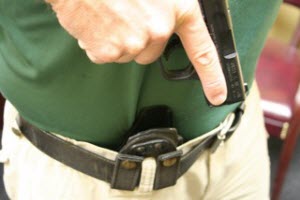
Some holsters, like this Safariland Model 18, are designed to remain open, allowing the user to re-holster their firearm with one hand.
www.personaldefensenetwork.comChecking Your Gear
One of the first things we cover in our one-handed manipulation and shooting blocks of instruction at U.S. Shooting Academy is gun and gear set-up. Obviously, the type of holster and magazine pouch you wear will affect how you operate your gun with one hand beyond the access considerations discussed above. Certain techniques require you to use your holster, belt, or magazine pouches to work the slide or secure the gun during a reload, and some gear works well for one-handed manipulation, while some just doesn’t work.
An example might be a high-quality leather pancake holster that collapses after the gun is drawn from it. Due to the fact that the holster collapses, it will be very difficult to secure the firearm in that particular holster to perform a reload. Holster selection and testing are critical, and you might not have the ability to pick a different holster (for example, a law enforcement agent/officer who is required to wear a certain rig).
What you can do is test your equipment by trying different one-handed techniques, so you know their limitations, and then find ways to work around the problems you may have. This takes time and dedicated training, and absolutely must be done to ensure you don’t end up having to figure this out during an actual fight!
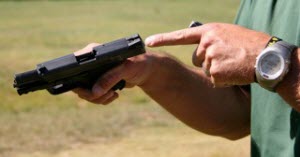
Rear sight design is critical when considering one-handed manipulations. This rear sight has a sloped design and would be difficult to use.
www.personaldefensenetwork.comFor example, one of the strong points of the Smith & Wesson M&P 9C that I carry is the fact that the slide lock/release lever is ambidextrous and I can operate it with both hands (not that I recommend using a slide lock/release–generally I do not) if I need to. Magazine release buttons should be inspected and tested for use with both hands, and if you carry a gun with a magazine release on the magazine well area, you will have to use a different technique to release the magazine with one hand only.

The knee method of securing the firearm is a great method, but it does limit mobility. Techniques should be evaluated for their pros and cons and trained for use in proper circumstances.
www.personaldefensenetwork.comSelecting the Right Technique
Techniques are usually best chosen by finding ones that are consistent and simple, but you will have to know several in order to operate with only one hand. The reason for this is that certain techniques will not work in all situations. During my one-handed survival shooting class, I always teach multiple techniques and discuss with students when each might be used. For example, I teach one where you use your knees to pin the gun and hold it while performing the reload, but this technique will not work if you are in the middle of a scuffle.
Training for One-Handed Manipulations
I absolutely must stress the importance of getting training from a qualified instructor if you are unfamiliar with these techniques. DO NOT go to the range and attempt any one-handed technique until you have trained that technique with an unloaded firearm with dummy training ammunition first.
When teaching, I stress lots (hours) of dry practice first, and then a simple live-fire drill that allows the user to test all the techniques during live fire. I recommend that a portion of each training session be devoted to one-handed shooting and manipulation, even if just a small part. You will find that a side benefit of shooting and manipulating a firearm with one hand only is increased skill with two hands when you go back to your normal operational techniques. After training with one hand, shooting with both is a breeze!
One-Handed Skills Are Not Optional
In closing, I want to emphasize that if you carry a firearm for self-defense, you NEED to know how to perform all critical manipulation skills with one hand only. For full-time law enforcement and military professionals, if your training personnel are not teaching you these skills, they are either too limited by their superiors or knowledge, both of which are wrong.
One of the worst scenarios in the world is getting into a fight that requires deadly force, having the use of only one hand and not knowing how to operate the handgun with it. Operating a handgun with one hand only is stressful enough. Having to figure out how to do it in the middle of a real fight is a recipe for disaster. Get some training in this critical area!
Author’s Note: I just filmed a segment for the Outdoor Channel’s S.W.A.T. Magazine TV show with PDN’s own Rob Pincus that focused on one-handed manipulation of the handgun. That got me in the mindset to write some conceptual tips on that type of training. I’d like to thank Rob for the opportunity to share such life-saving techniques with S.W.A.T. Magazine TV viewers. The series will be available later this year on DVD.
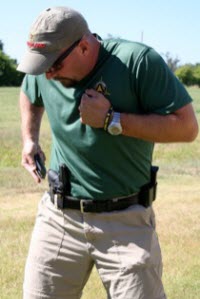
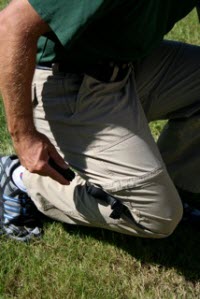

Genuinely when someone doesn't know then its up to other visitors that they will help, so here it takes place.
It is perfect time to make some plans for the future and it's time to be happy. I have read this post and if I could I wish to suggest you few interesting things or advice. Maybe you can write next articles referring to this article. I wish to read even more things about it!
I agree with Mr. Wong on the prexisting injury. I'm typing this one hand due to breaking the other in a grappling class the other night. At this moment, I wish I'd trained one handed a little more.
Very very informational. I have learned alot from Seeklander, a great teacher and a great author have really enjoyed the books.
Very good - another issue I often bring up in my CCW classes is the possibility that you may be restricted to the use of one hand only due to a pre-existing hand/arm injury PRE-DATING your defensive situation, and trying to learn one-handed techniques and adapt your existing carry gear is sub-optimal while you are already suffering from, and trying to recover from, something like a broken wrist from a traffic accident or sports injury, or maybe carpal-tunnel surgery. With respect to gun access, I have always carried a .38 snub in my LH front pocket to address this very issue - and, by necessity, I therefore also train in the one-handed employment of same. By the way, the "New York Reload" is a viable response to train-up for the eventuality of a malfunctioned primary gun - if you have the time and space available to get the primary back in the fight, fine; if not, the ability to get a backup weapon into the fight with one hand can potentially be a lifesaver.
Good stuff, Mike--us usual. Great material, excellent presentation. Bill